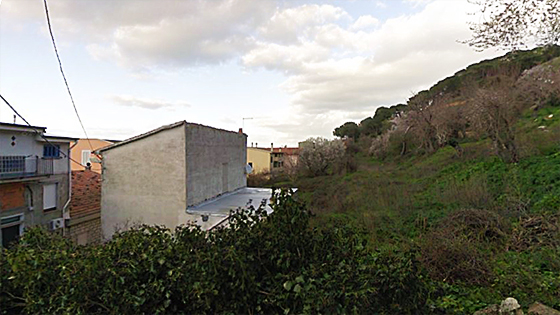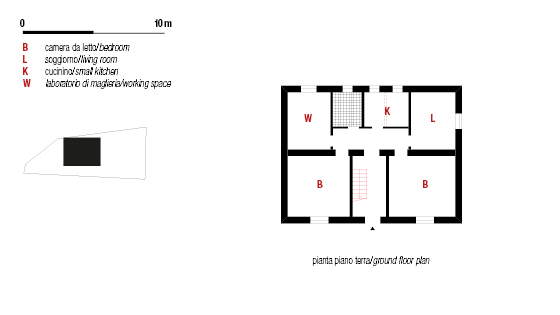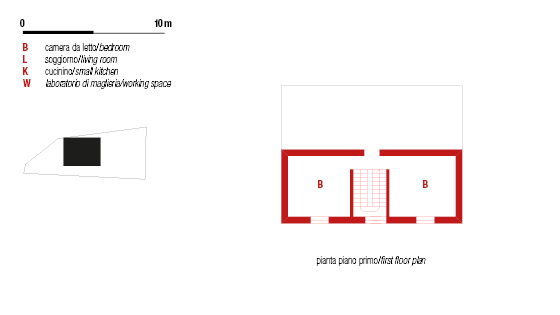2014/10/12
Bitti – una casa in autocostruzione/a self-built house
Una casa tra storia e memoria
Milena Farina
Quando la famiglia C. inizia a costruire la propria casa alla fine degli anni Cinquanta, Bitti è un ricco centro della Barbagia, impegnato in prevalenza nella pastorizia, che ha quasi raggiunto i 6.000 abitanti (circa il doppio rispetto alla popolazione attuale), la massima quota demografica della sua storia prima del progressivo spopolamento.
Nel 1958 Salvatore C., noto come “Battore de Bielle” dal nome del padre, lascia la casa dei genitori, ormai troppo piccola per la sua famiglia, composta dalla moglie Antonietta B. e i 3 figli Gabriele, Liana e Pietro. Salvatore e Antonietta hanno deciso di costruirsi la casa, tanto che lo stesso anno comprano un terreno in una zona residenziale semicentrale, a circa 700 metri dalla piazza principale del paese. La scelta dell’autocostruzione è diffusa nel paese e particolarmente naturale per Salvatore C., che aveva appreso insieme ai fratelli il mestiere del padre Bielle, artigiano e muratore (“maestru'e muru”) artefice di diverse opere importanti nel paese barbaricino tra cui la “Piazza Nova”.
Salvatore lavora alla costruzione della casa nel tempo libero e nei momenti di disoccupazione, coinvolgendo anche altri muratori suoi amici e qualche manovale. La casa è concepita da Salvatore e Antonietta come una costruzione semplice, funzionale, razionale, adatta alle esigenze della famiglia di un muratore e compatibile con le risorse disponibili senza indebitamenti.
La casa, ultimata nel 1961, è pronta a ospitare la famiglia, che nel frattempo si è allargata con la nascita dell’ultima figlia, Lucrezia, e anche una sorella di Antonietta, Lia, che esercita un'attività di maglieria artigiana: c’è una camera da pranzo con caminetto e forno adiacente per il pane “carasatu”, al quale é collegato un cucinino; una camera per Salvatore e Antonietta, che dormono con la neonata; una camera per Lia e i figli; una stanza in cui vengono sistemate le macchine con le quali Lia produce dei maglioni in lana. Il via vai dei clienti rende particolarmente viva la casa.
L’abitazione è semplice ma dotata di ogni comodità: l'acqua in casa e un bel bagno, la cucina a gas, una vaschetta in cemento armato per lavare i panni, la TV marca Telefunken acquistata a rate già nel 1962. Con la Tv la casa si trasforma la sera in un luogo d’incontro per diverse persone del vicinato, che vengono ospitate dopo cena per assistere agli sceneggiati o alle opere teatrali trasmesse dopo il carosello.
I figli crescono, vanno a studiare fuori, si sposano. Per un periodo una camera della casa viene affittata a una professoressa siciliana che insegna nel nuovo Liceo di Bitti. Anche il fratello di Salvatore, Mauro, va ad abitare nella casa e d’accordo con la famiglia realizza una sopraelevazione. Si modifica così la destinazione d’uso degli ambienti e si ricava un soggiorno a piano terra.
La casa diventa più grande ma gradualmente si svuota, seguendo lo stesso processo di spopolamento che interessa il paese.
A house between history and memory
Milena Farina
When the C. family started to build their own house at the end of the Fifties, Bitti was a rich village of the Barbagia, mainly engaged in sheep-farming. The village had reached nearly 6,000 people – about twice the current population and the highest peak before the depopulation trend of recent years.
In 1958 Salvatore C., better known as "Battore de Bielle" from the name of his father, left his parents' house, now too small for his family, which consisted of his wife Antonietta B. and three children, Gabriele, Liana and Pietro. Salvatore and Antonietta had decided to build their own house and in the same year they bought a plot of land in a residential area near the center, about 700 meters far from the village's main square. The choice of self-construction was usual in the village and particularly suitable for Salvatore C., who together with his brothers had learned his father's job: Bielle was a good craftsman and bricklayer ("maestru'e muru"),the author of several important works in the village including the "Piazza Nova".
Salvatore built the house in his spare time and during the periods of unemployment, helped by his friends and a few other builders. The house was designed by Salvatore and Antonietta as a simple, practical and rational construction, suited to the needs of a mason family and compatible with available resources without borrowing.
The house, completed in 1961, was large enough to accommodate the family, which in the meantime had expanded with the birth of the last daughter, Lucrezia, and the arrival of a sister of Antonietta, Lia, who operated as a knitting craft. There was a dining room with a fireplace and an adjacent oven to cook the “carasatu” bread, with a small kitchen attached; a room for Salvatore and Antonietta, who slept with the baby; a room for Lia and the other children; a room in which were placed the machines with which Lia produced wool sweaters. The comings and goings of customers made the home particularly lively.
The house was simple but equipped with every comfort: the water in the house and a nice bathroom, a gas stove, a concrete pan to wash clothes, the Telefunken TV set bought in installments as early as 1962. Thanks to the presence of the television, the house turned in the evening into a meeting place for several people of the neighborhood, which were hosted after dinner to watch the dramas or plays aired after “Carosello”.
The children grew up, went off to study, got married. One bedroom was rented for a period to a teacher from Sicily who was working in the new School of Bitti. A brother of Salvatore, Mauro, went to live in the house and built an additional floor in agreement with the family. The original destination of the rooms was modified and a living room on the ground floor was introduced.
The house grew larger but also gradually emptier, following the same process of depopulation that has affected the village in recent times.
№ 10/21
№ 1/1
Next project: → Trento – casa condivisa da ricercatori fuorisede/a researchers’ cohousing
Previous project: ← Palermo – abitare il “sacco”/living in the “sack”


